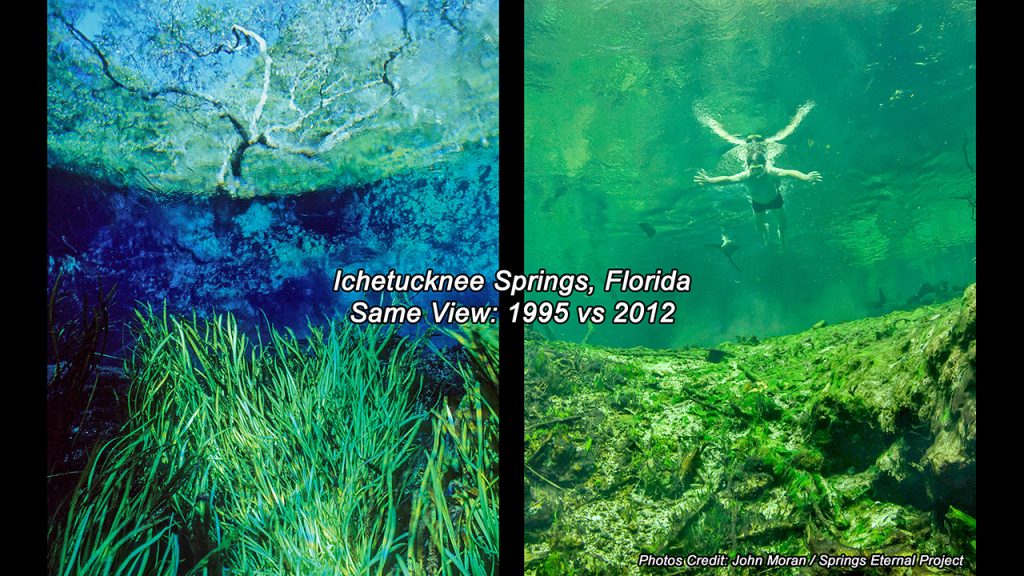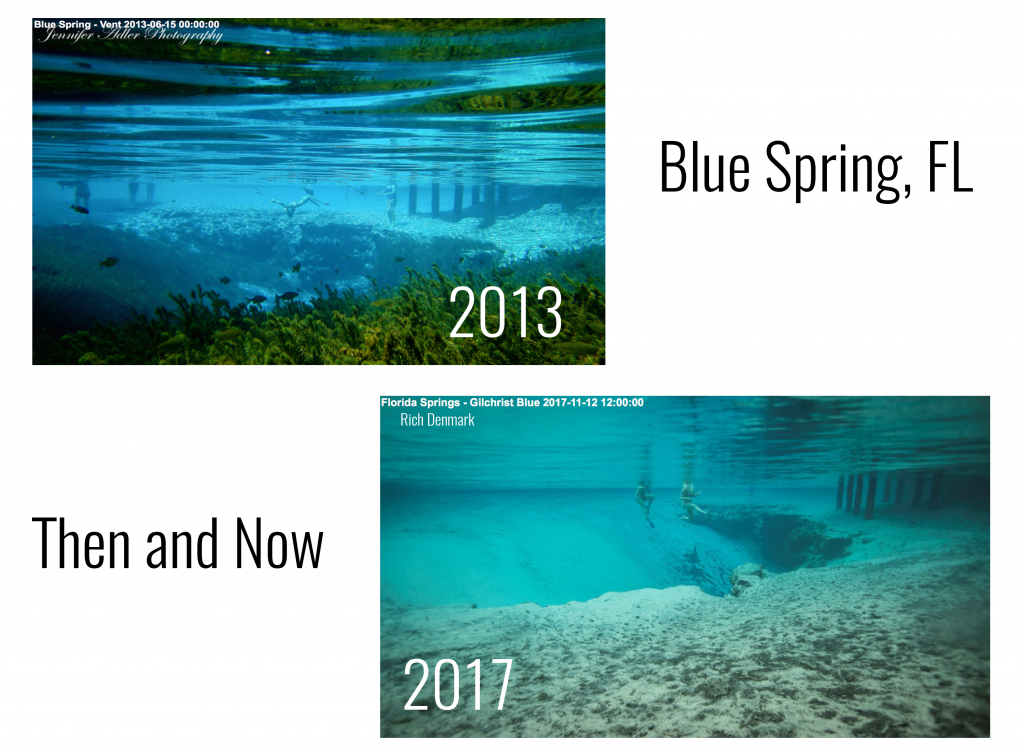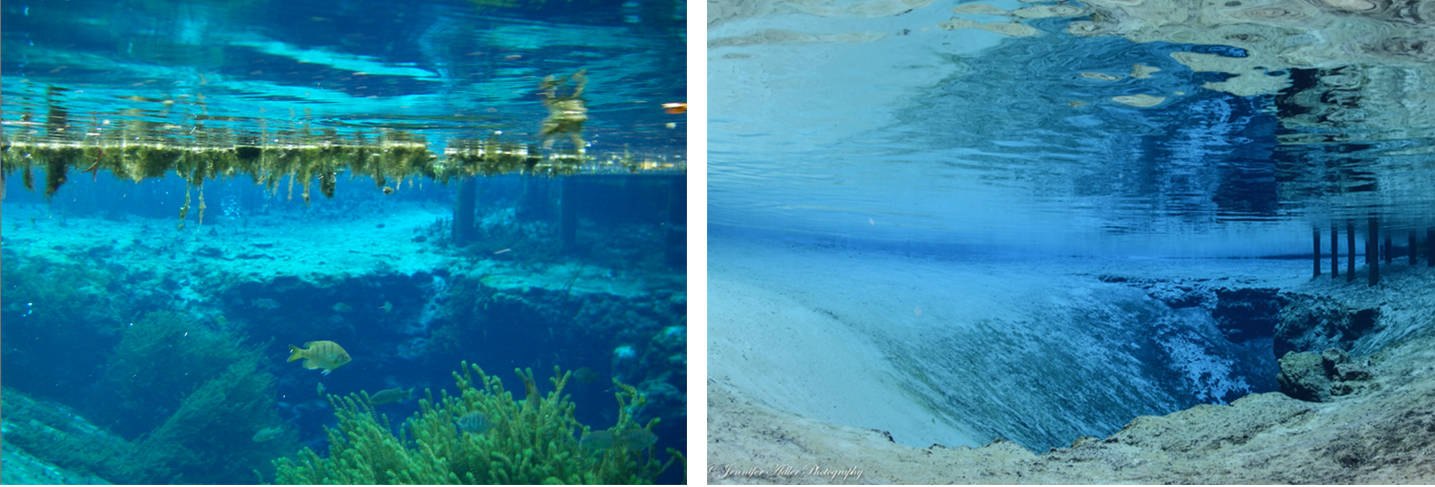
Florida’s Springs are imperiled.
Most are flowing 30% to 50% less now than their historical average. Some don’t flow at all except after big storms or abnormally wet periods. Nearly all have become overwhelmed with algae and bacteria (eutrophied) due to excessive nutrient pollution. The causes are straightforward and increasingly hard to ignore: groundwater over pumping, the overuse of fertilizers by agribusiness and homeowners, and insufficiently treated wastewater. Solutions exist, can be widely implemented, and would significantly improve spring water flows and spring water quality. Existing policies however have failed to even bend the steep downward trajectory of Florida’s springs. “Minimum Flows and Levels” (MFLs) appear to protect spring flows but, in reality, open the door to continued declines while people argue over the difference between natural and human causes. “Best Management Practices” (BMPs) portend to reduce nutrient loading but are not only unproven and unenforceable but not even conceptually capable of the needed nutrient reductions. Even as more and more attention and resources are directed at the condition of Florida’s springs, most continue to degrade: less and less flow, more and more nitrate and algae.
In the face of these declines, it’s easy to become disheartened and jaded. It’s even easier to become focused on reactionary measures aimed at what we don’t want and rooted more in emotion than in facts. This is, I believe, is epitomized by the highly publicized reactions to a permit renewal application filed with the Suwannee River Water Management District (SRWMD) for a bottled spring water plant down the road from Ginnie Springs operated by the Nestle Corporation (Nestle). The application requests that the SRWMD renew a standing permit that was first issued in the 1980s for the extraction of 5 million gallons per day (MGD) of groundwater from the Floridan aquifer to support spring water bottling. The same permit that was voluntarily reduced to 1.1 MGD by the property owners to prevent the possibility that it could be incorporated into one of the many groundwater pipeline schemes that are persistently proposed to transport water from relatively rural north Florida to the substantially more populous cities in central and south Florida. Through the years, several different companies have leased the property and access to the water, one of which was the Coca-Cola Company and the most recent being the Nestle.
My perspective on this issues is a product of 30 years of work on karst hydrogeology in Florida, more specifically from my work for Coca-Cola on mapping groundwater flow paths to the springs on the western Santa Fe River including Ginnie Springs and identifying the threats to the quality and quantity of flow to the springs, and even more specifically the evolution of my understanding of what it’s going to take to sustainably manage groundwater (synonymous with spring flow) in Florida.
The problems facing Florida’s springs are not technical and not a consequence of any one particular use or user. The real problems are instead failures of the established policies to take the necessary steps to put concrete limits on groundwater consumption and nutrient pollution. If we are to achieve sustainable spring flows, limits on groundwater consumption must be established and enforced and, in reality, must be lower than current levels. From a quantity perspective, who gets the water is irrelevant. All that matters is how much is taken. At present, not only is too much being used but there are no established limits. Conservation measures enacted by one user simply opens the door for new or larger allocations to other users. All that is required is that users that the water they want supports a “beneficial use.” So, while we can and should be proud of those engaged in conservation, the reality is that spring flows will continue to decline.
If we are to achieve sustainable spring water quality, limits on nutrient pollution must be established and enforced, and must be far lower than the current levels. Some say nutrient discharge levels will need to be cut across the board by 70% or more in order to meet water quality targets for Florida’s natural waters: 70% less nutrient loading from agriculture, 70% less nutrient loading from households, 70% less nutrient loading from wastewater treatment and disposal.
At present and for the foreseeable future, there is insufficient political will to achieve either of these needed changes. Year after year, proposed legislation that calls for the types of sweeping changes needed fails to receive sufficient public support for passage. While the political efforts that would result in real and positive change continue to fail due to lack of support, the public’s attention focuses on perceived impacts from individual users without regard to the actual impacts those users and uses have on the springs.
Bottled spring water is only one example. Though the entire industry uses around 1/100th of 1% of the groundwater extracted from the Floridan aquifer and produces none of the toxic nutrient loading that is killing the springs, it holds a disproportionate grip on the public’s attention to usage, impacts, and solutions. Put another way, if tomorrow the entire bottled water industry in Florida were to shut down, there would be effectively zero improvement at the springs in terms of either flows or quality. The little amount of water gained would very likely be quickly and quietly allocated to different users.
If on the other hand the roughly 400 bottles of water needed to produce a single bottle of milk were put to better use, say returned to the springs, and the associated nutrient loading to groundwater thereby eliminated, there would be a near immediate improvement in both flows and quality at the springs. This is simple math. They use far more water and produce drastically more nutrient pollution. Eliminating that use would therefore take longer to reallocate to new users and eliminate a huge portion of the nutrient pollution that is killing the springs.

Nearly every drop of water extracted from the Floridan aquifer and not returned, certainly from the entirety of the state north of Orlando and Tampa, and regardless of what it’s used for be that drinking water, green lawns, car washes, tomatoes, milk, soda, or bottled water reduces spring flows by an equal amount. Similarly, all the nutrient loading to groundwater, certainly west of central Orlando and Gainesville and south of Tallahassee, flows to the springs and contributes to the explosive algae infestations no one wants to become normal. The problems plaguing Florida’s springs, rather they be those enshrined as State Parks or those like Ginnie Springs that are privately owned, stem from these realities. Florida’s springs need allies not rhetoric, allies who help to build the public support necessary to achieve the only actions that will restore and preserve spring flows and spring water quality: caps on groundwater consumption and dramatic reductions in nutrient loading.
Regardless of corporate culture, spring water bottler’s economic self-interest is directly aligned with springs protection. Spring water cannot be treated and cannot be captured if there are no more springs. Spring water bottlers therefore rely on access to sustainable, high quality spring water. It follows therefore that they along with other entities like them can be strong allies for springs protection. It’s time Floridians stop focusing on rhetoric that fails to yield even as little as a diminished rate of springs degradation and start working toward real solutions anchored in the realities of water and nutrient budgets. The bottled water industry is not sucking Florida dry but denial and political inaction are.
As an organization that exists only to further the work needed to achieve and sustain the environmental quality needed to support the underwater ecosystems we, as divers love, and we as people need, our task must be to confront environmental problems from a perspective grounded in the realities of what’s going to be needed to achieve our goal. We must work for what we know we want rather than against what we think we don’t want. And to be successful, we’re going to need as many allies as we can muster.
As Project Baseline, we should and will seek to engage with the people and organizations who share our goals even if doing so is not palatable to some of our fellow conservationists. We should work with those entities and use our voices, our votes, and our wallets to foster the policies and the actions that are needed to restore and preserve the type of underwater world we want to dive in and pass along to future underwater explorers.
